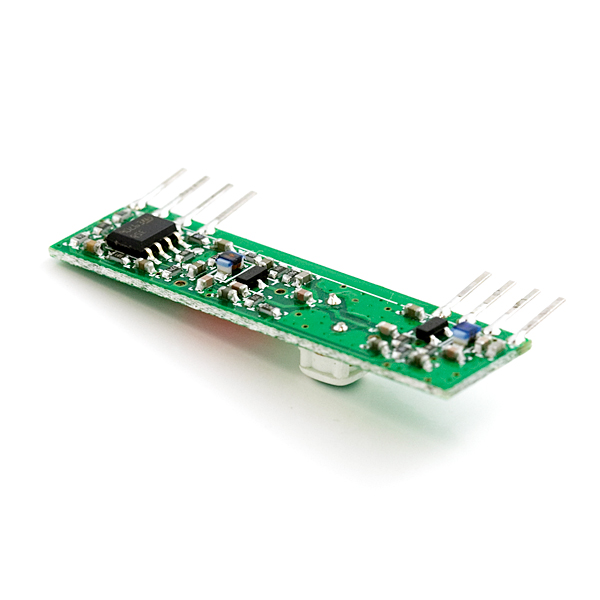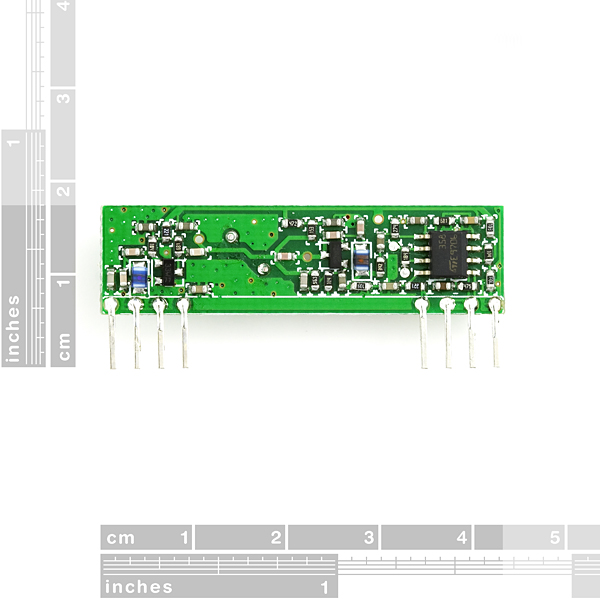RF Link 2400bps Receiver - 315MHz
Replacement: None. We are looking for a new supplier for these, but don't have a replacement yet. This page is for reference only.
Sold as a receiver only. This receiver type is good for data rates up to 2400bps and will only work with the 315MHz transmitter. Multiple 315MHz receivers can listen to one 315MHz transmitter.
This wireless data is the easiest to use, lowest cost RF link we have ever seen! Use these components to transmit position data, temperature data, even current program register values wirelessly to the receiver. These modules have up to 500 ft range in open space. The receiver is operated at 5V.
We have used these modules extensively and have been very impressed with their ease of use and direct interface to an MCU. The theory of operation is very simple. What the transmitter 'sees' on its data pin is what the receiver outputs on its data pin. If you can configure the UART module on a PIC, you have an instant wireless data connection. Data rates are limited to 2400bps. The typical range is 500ft for open area.
This receiver has a sensitivity of 3uV. It operates from 4.5 to 5.5 volts-DC and has digital output. The typical sensitivity is -103dbm and the typical current consumption is 3.5mA for 5V operation voltage.
- 315 MHz Operation
- 500 Ft. Range - Dependant on Transmitter Power Supply
- 2400 bps transfer rate
- Low cost
- Extremely small and light weight
- KLP Walkthrough Tutorial
- Good AVR Tutorial
- Receiver Datasheet
- Another Very Helpful AVR Tutorial - Thanks Eric Forkosh!
Comments
Looking for answers to technical questions?
We welcome your comments and suggestions below. However, if you are looking for solutions to technical questions please see our Technical Assistance page.
Customer Reviews
No reviews yet.




I had difficulty getting correct/accurate data out of this chip. I stumbled upon this site and found it EXTREMELY useful. Now, 100% accurate data. I hated this transmitter until I found this site. Its for PICAXE but can be adapted
http://quicktrip.co.nz/jaqblog/index.php?option=com_idoblog&task=viewpost&id=25&Itemid=8
Anyone found an alternative 315MHz RF Receiver?
is there alternatif for this?
is there something i can use instead of this now?
I can't wait for these to be back in stock. Apparently they can be detuned to 310MHz so that they can be used to receive X10 home automation signals with an arduino. see this link http://brohogan.blogspot.com/2010/10/receiving-x10-rf-transmissions.html
does it receive signal from pt 2262 circuits
I can see in the diagram from the datasheet a capacitor connected with the antenna, what is it for? and whats a good value for it?
I saw that too... assumed it was stray C. Haven't needed it with our ap. BTW, by adding a similar length ground wire we increased our LOS operation from ~500 feet to >800 feet outdoors (the lower frequency improves brush penetration over the 2.4GHz options
I'm trying to use this receiver to power some EL wire when it receives a strong signal. However, it seems to be picking up a lot of random fuzz in the area, and is powering the EL wire all the time. Any suggestions on how to make it only respond to a solid signal? To make the matter even more fun, I'm trying to do this all without a microcontoller.
I can see how to do it with an MCU, of course, but any suggestions on smoothing out the 'fuzz' it's picking up without one? Thanks!
Very easy to use with Arduino and the right library. Have written about it here: http://bit.ly/cNdzV7
Does anyone know if these have an FCC ID? If you use them in something commercial do you need to do your own FCC certification? That's one of the best parts about the Xbee, it comes with it's own FCC ID.
I found this receiver and the recommended transmitter very easy to use with the VirtualWire library and my Arduino.